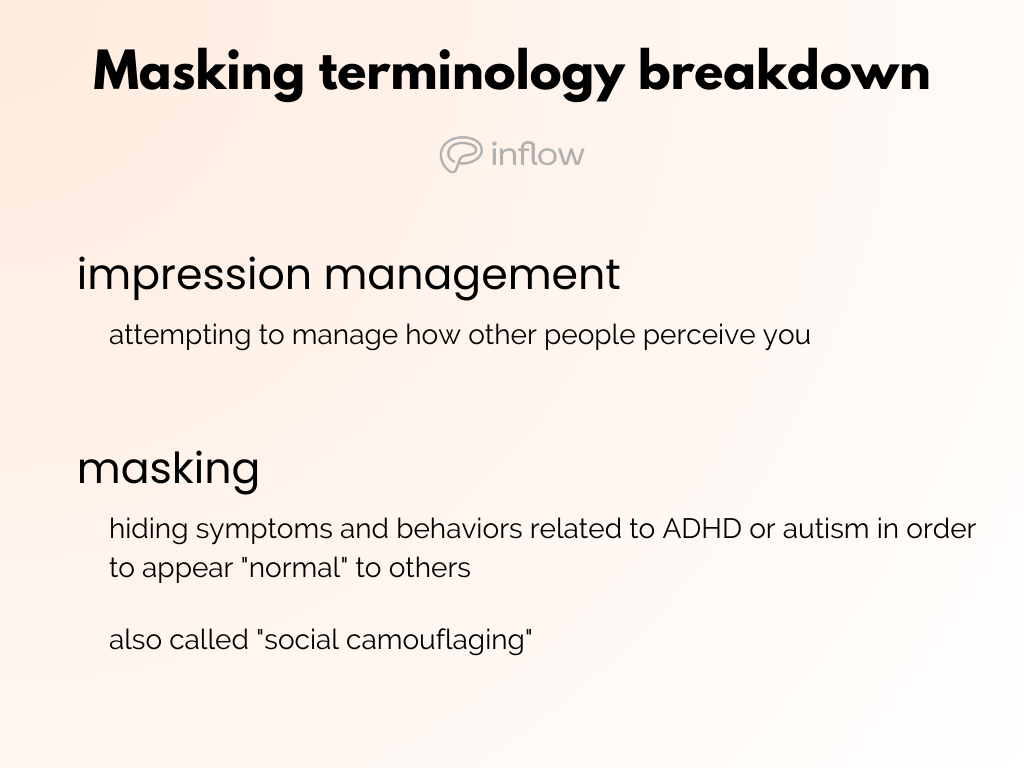The term "neurodivergent" can be broken down into two parts: "neuro-," which relates to the nervous system or brain, and "divergent", which means different. So, "neurodivergent" essentially refers to having a brain different from what's considered "normal".
Of course, being different isn't a bad thing. But we live in a society that often values conformity; people want to fit in, not stand out. Community, acceptance, a sense of belonging—whatever you want to call it—is a basic human need.
It's not uncommon for people with ADHD and autism to try to hide their symptoms to fit in with neurotypical peers. While this behavior can be intentional, it is often unconscious—a habit developed over a lifetime of being corrected, reprimanded, or judged by others.1
The worst part?
Because they're unaware of their masking behaviors, many ADHDers go most of their lives without proper diagnosis and treatment. Not to mention, the burnout that masking can cause is unmatched.
Too long; didn't read
- Neurodivergent people often try to hide or suppress their symptoms, a behavior known as masking.
- Masking can lead to delayed ADHD or autism diagnosis, less social support, low self-esteem, and burnout.
- There are coping strategies you can use to avoid burnout from masking, including learning to identify and change harmful masking behaviors, setting boundaries, and working toward emotional acceptance and unmasking of your neurodivergence.
The masking phenomenon
ADHD masking, also called social camouflaging, is when someone hides their symptoms — consciously or unconsciously — to appear neurotypical. It's a form of impression management that everyone does to a certain extent, but for those with ADHD or autism, it takes significantly more effort.2

Why do people with ADHD mask their symptoms?
For neurodivergent folks, masking isn't just a matter of putting their best foot forward or adapting to their environment. Instead, adopting "normal" behaviors to blend in is often necessary to avoid negative consequences, judgment, or social exclusion.
If the masking behavior is conscious, it may be out of fear of being labeled lazy, irresponsible, or disruptive. So, we conform to societal expectations, ultimately convincing others — and sometimes, ourselves — that we do not have ADHD.
Common ADHD traits in adults (with examples)
Note: These traits may not be readily noticeable to others if you tend to mask them.
- Impulsivity: Acting without thinking about consequences (risk-taking), making hasty decisions, interrupting others, and impulsive spending habits
- Hyperactivity: Restlessness, difficulty sitting still, constant foot-tapping, excessive fidgeting, and feeling the urge to get up and move around regularly
- Inattention: Difficulty focusing on tedious tasks, zoning out during conversations, being easily distracted, and frequently making "careless mistakes"
- Disorganization: Clutter everywhere, frequently misplacing belongings, difficulty managing finances, and inconsistent or nonexistent routines
- Forgetfulness: Regularly forgetting appointments or meetings, missing deadlines, and frequently losing track of conversations or what someone has said
- Emotional issues: Low self-esteem, feelings of guilt or shame, rejection sensitivity, angry outbursts, irritability, and frequent mood swings
- Procrastination and avoidance: Putting off tasks until the last minute, anxiously avoiding responsibilities, and feeling overwhelmed by the idea of starting a new task
Exhausting list, right?
Now imagine how exhausted you might be if you're constantly overcompensating by masking your ADHD symptoms.
Embrace your neurodivergence with Inflow! Learn about ADHD masking and burnout with educational learning modules, expert coaches, and a community that understands and celebrates your unique brain. Get started with Inflow today!
ADHD masking: 7 warning signs that you're about to burn out
Do any of these sound familiar? If so, you may be on your way to burnout.
1. Unexplained exhaustion
The mental effort required to hide ADHD symptoms can be draining.
If you're exhausted and can't find the motivation or energy to do simple tasks, it could be an early sign of masking burnout.
Experiencing constant fatigue despite getting enough sleep and otherwise being healthy might mean you've been masking too much.
2. Not "feeling like yourself"
Have you ever felt disconnected from yourself or like you were "putting on a show" for other people?
If you can't remember the last time you felt truly relaxed and content in social settings, it may be because you've buried your ADHD symptoms under a heavy mask.
3. Worsened anxiety or depression
Many people with ADHD and autism also have anxiety, depression, or both. Hiding your true self, whether because of society or fear of judgment, can negatively affect your mental health.3
The constant struggle to keep up appearances can make you feel alone and hopeless, making it harder to stay motivated and believe in yourself. It's like fighting against your own mind, with anxiety and depression creating more hurdles than you have the stamina for.
4. Difficulty relaxing
If you're constantly concealing your neurodivergence, you probably relate to the feeling that you must always be in control. As a result, it's probably difficult for you to unwind — even in calm environments.
And - as you may have guessed - a lack of rest only contributes to burnout.
5. Strained relationships
In personal and romantic relationships, constant masking can...4
- create a barrier to intimacy, leading to misunderstandings and conflict.
- emotionally drain you, making it hard to engage with friends and family.
- make you feel like you can't be your true self in relationships, leading to resentment and anger.
In the professional realm, full-time ADHD masking can...
- make you appear distant or unapproachable, causing misunderstanding.
- slow down your work, affecting your ability to meet deadlines.
- prevent you from being yourself, reducing job satisfaction and missed opportunities.
In all instances, the strain caused by masking can lead to "burned bridges", which increases feelings of isolation, anxiety, and depression.
6. Perfectionism
It seems kind of paradoxical, but many people with ADHD actually have perfectionistic tendencies. They'll strive for perfection because they're trying to hide their struggles with memory, organization, or focus.
7. Self-medication
Unfortunately, ADHDers who consistently hide their symptoms may turn to alcohol or drugs as a way to cope. However, using substances as self-medication can be risky and should not be taken lightly.
If you find yourself relying on drugs or alcohol to manage, don’t hesitate to reach out for support.
🖤 If you’re struggling with substance misuse, you’re not alone! Resources: SAMHSA, NCADD, AA (for US and Canada), NA
How to cope with burnout caused by masking
While you're already doing your best to cope with and manage your ADHD, you should know that you deserve better than just striving for conformity. There are healthier ways of dealing with your symptoms, starting with removing the mask.
Education and awareness
Much like ADHD and autism, masking occurs on a spectrum. It can be conscious or unconscious, effortless or exhausting, healthy or unhealthy.
It's also important to understand the difference between masking and compensatory strategies.
Compensatory - or adaptive - strategies are used to improve daily function (for example, setting reminders or highlighting notes), whereas masking is performative and done to try and hide symptoms.
Take a moment to reflect on your masking behaviors to determine which ones are helpful and which are emotionally taxing.
🧠 ADHD research: When people take the time to learn more about their ADHD symptoms, they feel more validated, and their self-image improves.4
Emotional regulation skills
ADHD masking can contribute to mental health difficulties, such as depression or social anxiety, but it can also stem from low self-esteem or shame. ADHDers tend to be sensitive, so learning effective emotional regulation strategies can help.
Emotional regulation strategies:
- FOUL method — helps with impulsive emotional responses and anger management
- Externalize your thoughts and feelings by writing in a journal — helps to prevent spiraling out of control
- RAIN method — helps with rejection sensitivity and improves mindfulness
- Deep breathing exercises — helps with calming down
- Use the 5-4-3-2-1 grounding exercise to engage your senses — helps with unexpected panic attacks and anxiety
Social support
If you're comfortable with the idea, talk to trusted friends or family about your ADHD symptoms and how you're struggling with masking burnout.
Look for other ADHDers or online support groups to feel less alone and more connected. And, of course, you can always find professional help from a therapist or ADHD coach!
Final thoughts
Masking and camouflaging ADHD or autism symptoms to fit in can be harmful. The pressure to conform and fear of judgment can lead to delayed diagnosis, limited support, low self-esteem, and burnout.
Recognizing the signs of masking burnout, such as exhaustion, disconnection, anxiety, strained relationships, and self-medication, is essential.
But remember, you don't have to face these challenges alone! Seek education, practice emotional regulation, lean on social support, and don't hesitate to reach out to trained professionals.
Your journey to embracing your neurodivergent self is only just beginning.
-
Sources
1 The Burden of Adult ADHD in Comorbid Psychiatric and Neurological Disorders | The Phenotypic Expression of ADHD in Adulthood (2020)
2 Psychology Theses | "I wish I could just be myself": Social camouflaging, internalized stigma, and internalizing mental health problems in adult ADHD (2022)
3 Molecular Autism | Is social camouflaging associated with anxiety and depression in autistic adults? (2021)
4 SSM - Qualitative Research in Health | The experiences of adults with ADHD in interpersonal relationships and online communities: A qualitative study (2023)









